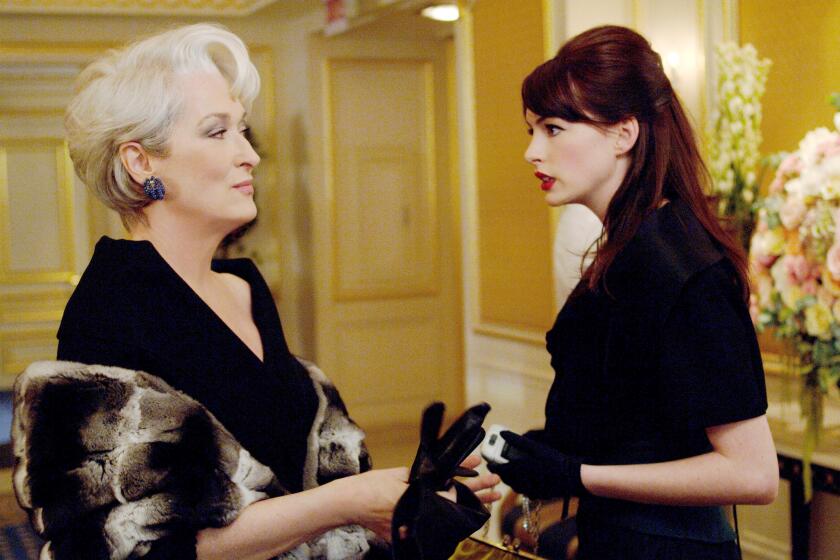A Second Look: ‘Apocalypse Now’
- Share via
An art movie made on a blockbuster scale, Francis Ford Coppola’s “Apocalypse Now” is a cult film for the ages, an imperfect classic whose force and stature have only grown with time. Released in summer 1979, having premiered a few months earlier in an unfinished version at the Cannes Film Festival, it was a monumental work of momentous import: Hollywood’s much-trumpeted attempt to close the book on the national nightmare of the Vietnam War and in retrospect, a tombstone that marked the end of American cinema’s 1970s golden age.
FOR THE RECORD:
“Apocalypse Now”: In the Oct. 17 Calendar section, the Second Look column about two new DVD packages for the film “Apocalypse Now” described “Hearts of Darkness: A Filmmaker’s Apocalypse,” included in the three-disc set, as “Eleanor Coppola’s valuable behind-the-scenes documentary.” She was one of three directors; the others were Fax Bahr and George Hickenlooper. —
“Apocalypse Now” arrives in the Blu-ray, high-definition DVD format this week in fittingly expansive two-disc and three-disc editions. Both include the 153-minute 1979 cut and “Apocalypse Now Redux,” the 2001 re-edit that added about 50 minutes to the running time, and the film is being presented in its original 2.35:1 aspect ratio for the first time on home video. There are also hours’ worth of supplemental material, a mix of previously available featurettes and new interviews with Coppola and others, and the three-disc “Full Disclosure” version also includes “Hearts of Darkness: A Filmmaker’s Apocalypse,” Eleanor Coppola’s valuable behind-the-scenes documentary.
The epic back story has long been inseparable from the film itself. The project originated, all the way back in 1970, with a simple concept — Joseph Conrad’s “Heart of Darkness” in a Vietnam War context — and a John Milius script that George Lucas was to direct; by the mid ‘70s, Coppola had rewritten the screenplay and Lucas had his sights set on “ Star Wars.” Once production was finally underway in the Philippines, Coppola fired the original lead, Harvey Keitel. His replacement, Martin Sheen, suffered a heart attack. Marlon Brando showed up out of shape. A typhoon destroyed the set. Amid a steady drip of negative publicity — reports of ballooning costs, rumors of rampant excess — Coppola insisted on finding the story as he went, dragging a huge production and a fatigued cast and crew with him.
The drawn-out process meant that “Apocalypse Now,” touted as the first major Vietnam War movie, was beaten to theaters by such films as “The Deer Hunter” and “Coming Home.” If Coppola’s phantasmagoric reverie has aged better than the Vietnam chronicles of the period, that is in large part because it was not really about Vietnam. As history, “Apocalypse Now” could be accused of any number of omissions. As a literary adaptation, it is not particularly imaginative, and as a metaphysical rumination on good and evil, it is not especially profound.
But where it excels is as a sensory experience, from editor Walter Murch’s detailed sound work to the cinematography of Vittorio Storaro, which conjures an incandescent delirium of orange flames and yellow napalm clouds against an emerald jungle. But more than a druggy fever dream, “Apocalypse Now” is also a visceral evocation of the confusion and madness of war — albeit one that is unafraid to take a flamboyant aesthetic approach, as is evident right from its immortal opening shot, the jungle inferno scored to the Doors.
The most common complaints about “Apocalypse Now” have to do with the ending. Charged with finding — and killing — Brando’s gone-native renegade Col. Kurtz, Sheen’s Capt. Willard murmurs, early on, “I really didn’t know what I’d do when I found him.” Nor does the film, really. Brando’s Kurtz all but sinks the temple-of-doom finale in a swamp of philosophical musings and poetic citations.
The problem remains in “Redux,” which Coppola considers the definitive cut. The longer version has its fans, and there is a sense in which more is more: “Redux” does, after all, prolong the ritualistic trance that is Willard’s journey upriver and the film’s reason for being. The main addition is a long sequence at a French plantation that allows for an opiated love scene and the blunt observation that the Americans were fighting for “the biggest nothing in all of history.” But some of the original’s effective absurdist interludes — the encounter with the surf-obsessed Robert Duvall and the Playboy playmates’ U.S.O. tour — are pointlessly distended.
Still this is a film so potent it can survive just about anything, even the needless meddling of its creator. It has always worn its flaws and incongruities well, from the atonal ending to the almost film noir-ish narration (written by war correspondent Michael Herr). Put another way: “Apocalypse Now” would likely feel off-kilter and misshapen in any form, but it would remain a masterpiece all the same.
calendar@latimes.com
More to Read
Only good movies
Get the Indie Focus newsletter, Mark Olsen's weekly guide to the world of cinema.
You may occasionally receive promotional content from the Los Angeles Times.










